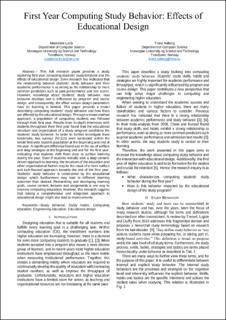| dc.contributor.author | Lorås, Madeleine | |
| dc.contributor.author | Aalberg, Trond | |
| dc.date.accessioned | 2021-02-12T07:06:23Z | |
| dc.date.available | 2021-02-12T07:06:23Z | |
| dc.date.created | 2021-01-04T14:08:56Z | |
| dc.date.issued | 2020 | |
| dc.identifier.issn | 1539-4565 | |
| dc.identifier.uri | https://hdl.handle.net/11250/2727547 | |
| dc.description.abstract | This full research paper presents a study exploring first year computing students' study behavior and the effects of educational design. Some research has indicated that the relationship between students' study behavior and their academic performance is as strong as the relationship to more common predictors such as past performance and test scores. However, knowledge about students' study behavior, how behavior develops and is influenced by program and course design, and consequently, the effect various design parameters have on learning is limited. This paper presents a model describing computing students' study behavior and how these are affected by the educational design. Through a mixed-method approach, a population of computing students was followed through their first year. Results from in-depth interviews with students throughout their first year found that the educational structure and organization of a study program conditions the students' study behavior. In order to further investigate these tendencies, two surveys (N=215) were conducted within the whole first-year student population at the beginning and end of the year. A significant difference found was in the use of surface and deep strategies at the beginning and end for the first year, indicating that students shift from deep to surface learning during the year. Even if students initially seek a deep content-driven approach to learning, the structure of the education and other organizational factors may be the cause of a more surface and task-focused approach towards the end of the first year. Students' study behavior is constrained by the educational design, which furthermore may lead to different learning outcomes than desired. Researching and developing learning goals, course content, lectures and assignments is one way to improve computing education; however, this research suggests that taking a comprehensive and integrated approach to educational design might also lead to improvements. | en_US |
| dc.language.iso | eng | en_US |
| dc.publisher | Institute of Electrical and Electronics Engineers (IEEE) | en_US |
| dc.relation.uri | https://ieeexplore.ieee.org/stamp/stamp.jsp?tp=&arnumber=9274285 | |
| dc.title | First Year Computing Study Behavior: Effects of Educational Design | en_US |
| dc.type | Peer reviewed | en_US |
| dc.type | Journal article | en_US |
| dc.description.version | publishedVersion | en_US |
| dc.source.journal | Conference Proceedings - Frontiers in Education Conference | en_US |
| dc.identifier.doi | 10.1109/FIE44824.2020.9274285 | |
| dc.identifier.cristin | 1864893 | |
| dc.relation.project | NOKUT (Nasjonalt organ for kvalitet i utdanningen): 16/02049 | en_US |
| dc.description.localcode | © 2020 IEEE. Personal use of this material is permitted. Permission from IEEE must be obtained for all other uses, in any current or future media, including reprinting/republishing this material for advertising or promotional purposes, creating new collective works, for resale or redistribution to servers or lists, or reuse of any copyrighted component of this work in other works. | en_US |
| cristin.ispublished | true | |
| cristin.fulltext | original | |
| cristin.qualitycode | 1 | |
